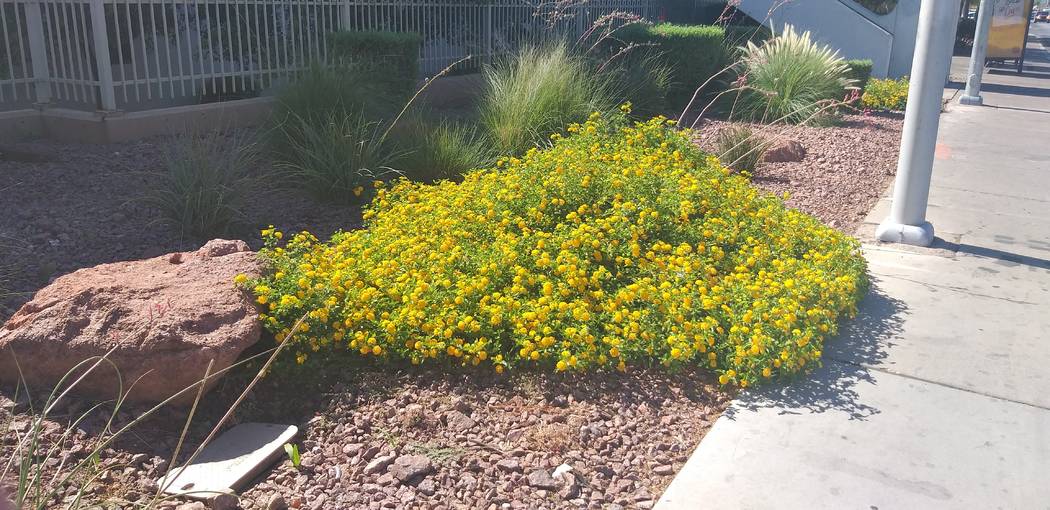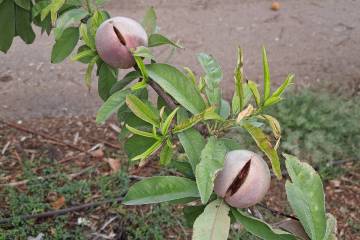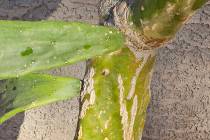Cutting tree roots always damages the tree
Q: When our landscapers installed new water lines for irrigation, they cut through two major roots on a Chitalpa tree. One root was 4 inches in diameter, and the other 1½ inches in diameter. These water lines could have been installed under the roots instead of cutting them. I am not sure why they did it this way. I am concerned about the future health of the tree.
A: Whether this is a problem for the tree is a difficult question to answer. Will cutting the roots of a tree cause it to die? Cutting tree roots always damages the tree. Can the tree recover from this damage? The right answer is: It depends. From your description, the root removal sounds ominous.
You can typically remove about one-third of the total roots with no problem. This is done sometimes when trenches are cut in the soil for burying irrigation lines. But when roots are cut, about one-third of the top should be removed as well. This removal of part of the top puts the top and roots back in balance with each other. How much of the total roots was removed in your tree’s case? That is difficult to estimate.
Look at the distribution of water applied for irrigation. This helps determine where the roots might be. Roots grow toward water because the soil is wetter in these locations. If there is a lawn close to the tree, then roots grow vigorously toward the lawn and less vigorously toward its own drip emitters. If other plants are growing near the Chitalpa, tree roots will likely grow toward the majority of drip emitters because there is more water there.
At the very least, remove about one-third of the top. Remove entire limbs rather than giving it a “butch haircut” and removing the ends of lots of branches. Removing two or three major limbs is probably enough.
As a precaution, I would stake this tree. Major roots of trees are used for tree stability, particularly during strong winds. The tree might need to be staked until the roots secure the tree in the ground. I would do it in case it is needed. Don’t wait until the tree starts to lean because of strong winds. Remove the stakes when the tree is stable. This might be one season of growth for smaller trees or up to three years for larger trees.
Q: I have some lantana I bought recently, and I was going to keep them in the containers through the winter and plant them in the spring. I understand they will turn brown this winter.
A: Plant them now, even though it is cold. Don’t wait for spring weather to plant. Plus, they won’t need as much attention if they are planted.
When people ask me the best time to plant, I tell them in the fall or spring months. In our relatively warm winter climate, however, plant any time through the winter months. It’s just best done during the fall and spring months because the soil is warmer, and their roots have a better chance of establishing in the surrounding soil during these times. Spring and fall months are better times of the year for the plants and planting. Avoid fall months when planting palms.
The massive amount of soil surrounding plant roots is a big help moderating the soil temperature as well as retaining soil moisture. You don’t need to water as often. In cold climates like the upper Midwest, loss of plants in containers due to root death from freezing temperatures is a problem.
Here, those types of concerns are seldom a problem. But keeping plants in containers for long periods of time is always a concern in any climate.
Let the soil after planting help create less work for you. Just remember to take them out of the containers and plant them properly.
Amend the soil three times the width of the container, take the plant out of the container and plant it so that soil is the same height both inside and outside the container. Make sure you plant in wet soil, not dry soil, even though you are watering afterward.
Q: Do you have any advice on digging and transplanting a sago palm this time of year? It’s the roots I’m considering. I failed last time maybe because it was too hot.
A: The ideal time to move sago palm, or cycad, is in the early fall or early spring, but you can do it now, even though its cold. It’s just not optimum. Evaluate your situation. If it has been in the ground more than three years, it is more difficult to move without damaging it. It helps if it was drip-irrigated with no other irrigation within 10 feet or so. This isolates the roots and keeps what you need to move closer to the plant.
Two things are important when you move a plant: Take as much of the roots and soil as possible during the move, and reduce the top by one-thrid to compensate for root losses during the relocation. You will have more success if it is moved into a spot with light shade, not full sun.
Here’s the process. I will put more information on my blog for you.
Remove fronds from the bottom toward the top so the remaining fronds are no more than a 45-degree angle from horizontal. The central fronds should be protected. The older palm fronds can be removed. Sago palm grows from the center straight up, and the fronds become lower with age. Mark which side of the plant faces north. You will orient this side to the north again when planting.
Prepare the soil and hole in the new location so you can place it into its new home and plant it as quickly as possible. The hole should be about the same depth as the rootball you are moving. The hole with amended soil will be much bigger.
Move everything away from the sago palm so that it is surrounded by bare soil, and then water the soil until it is sopping wet. Using a sharp, clean shovel, slice the roots of the palm at about 12 inches from the trunk. Otherwise, leave it undisturbed. The next day, after water has drained, leverage the plant upward carefully from its old location while cutting any remaining roots that might hold it back.
Placing the rootball and plant on an old piece of carpet or strong fabric by lifting the rootball. Carefully move the plant to its new location without breaking the soil around the rootball.
Orient the sago palm with the north side facing north, and backfill around the rootball using amended soil as a soil slurry to remove air pockets. It will not need to be staked. Add any amendments to the soil you feel is necessary to improve rooting. I personally don’t use anything more than the amended soil.
After the soil has settled and starts to dry, cover the area surrounding the sago palm with wood chips. Wood chips are a better soil covering (mulch) than rock for sago palm.
Q: I need suggestions for watering times and days to water in the summer for sprinklers watering trees in lawns, lantana bushes and rose bushes with drip irrigation.
A: When watering trees in a lawn, give the trees extra watering separately from the lawn, since the trees should be watered more deeply than the grass. In the summer, do this about every two weeks in sandy soil, less often in heavier soils. Grass is watered 8 to 12 inches deep, while small trees (less than 20 feet tall) are watered 18 inches deep and medium-height trees (less than 40 feet tall) are watered 24 inches deep. This can be done with a sprinkler on the end of a hose and a mechanical timer. This improves tree growth and establishment if the lawn is being watered carefully.
Watering times for other plants are also suggested by your water provider. Lantana is a shallow-rooted, small, woody shrub. It should be watered about 12 inches deep and no more than every other day in the summer. Water all its roots on one day, and then hold off at least one day before watering again.
Lantana will tolerate rock covering the soil surrounding it. Just make sure you apply fertilizer about three times each year. When the top turns brown, cut it back to 1 to 2 inches above the soil.
Roses are different. Watering frequency is the same as lantana, but they don’t like the soil covered in rock. They like wood chips that disintegrate, covering the soil surface and surrounded by soil that is rich. Plant them in amended soil, and keep the soil covered with wood chips.
Bob Morris is a horticulture expert and professor emeritus of the University of Nevada, Las Vegas. Visit his blog at xtremehorticulture.blogspot.com. Send questions to Extremehort@aol.com.





























